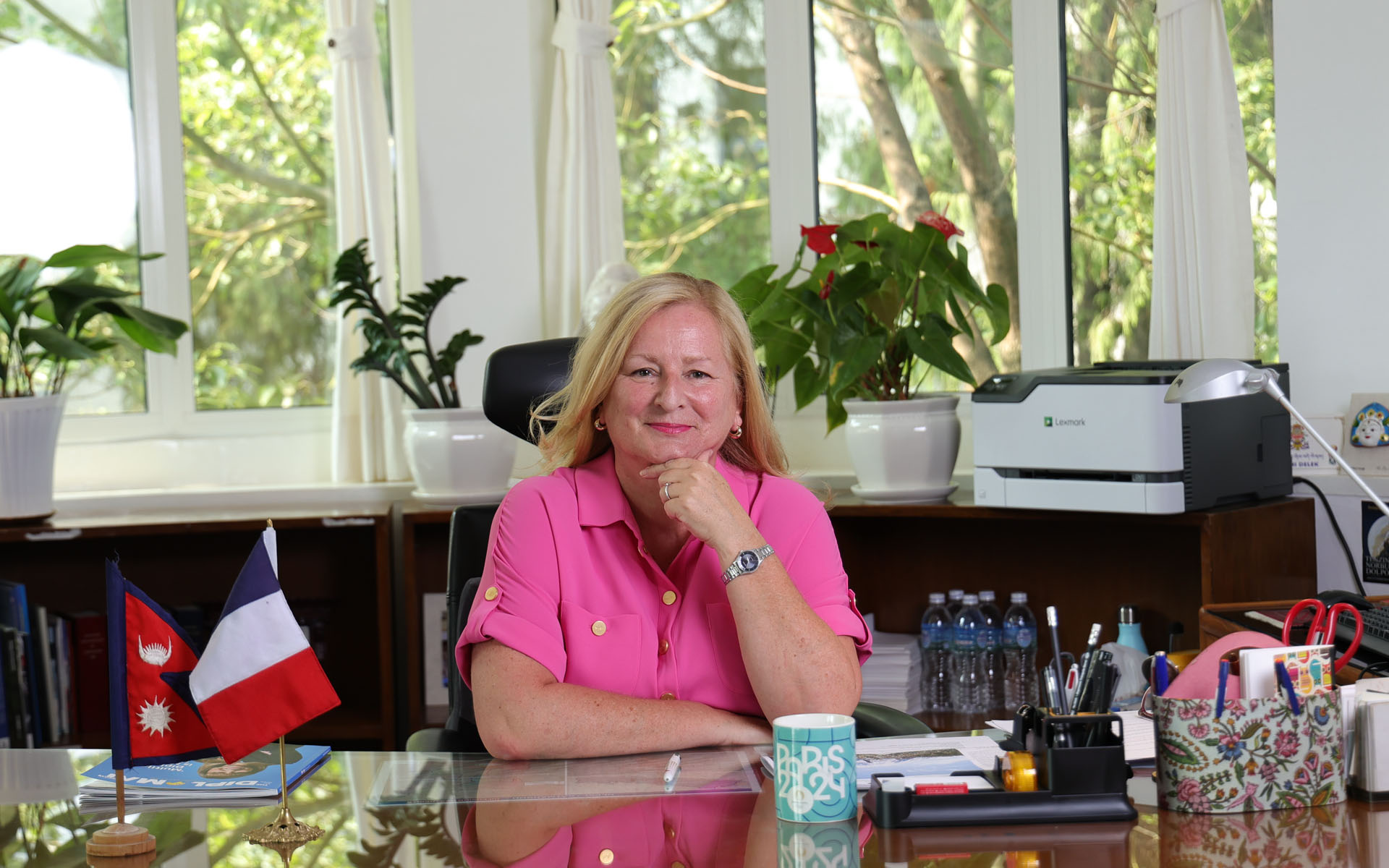
After establishing bilateral relations with the United Kingdom, the United States, and India, Nepal established diplomatic relations with France on April 20, 1949. Since then, the two countries have shared more than seven decades of close and friendly ties. France, a leading European power and a permanent member of the United Nations Security Council, has long been a valued partner to Nepal.
Representing France in Nepal is Ambassador to Nepal, H.E. Virginie Corteval, who assumed office in Kathmandu on September 3, 2024, to maintain and elevate ties between the two countries. Interestingly, H.E. Corteval is no stranger to Nepal. Earlier, she served at the French Embassy in Kathmandu in a different capacity from 2012-2015.
Born in 1963, Ambassador Corteval is a seasoned diplomat at the French Ministry for Europe and Foreign Affairs. Over her career, she has held various roles both in Paris and abroad. She served in various diplomatic capacities in Manama, Edmonton, London, Dhaka, Amsterdam, Kuala Lumpur, and Kathmandu. The diplomat also served as Consul General in Calcutta (2018–2021) and Deputy Head of Mission in Nicosia, Cyprus (2021–2024).
In an exclusive conversation with Jagdishor Panday of The Diplomat Nepal, Ambassador Corteval spoke about the long-standing Nepal-France partnership, shared interests in mountaineering and development, and her personal reflections on Nepal – past and present.
How would you describe Nepal-France relations?
We have long-standing diplomatic relations with Nepal, one that was established on April 20, 1949. So, this year marks the 76th anniversary of our bilateral relations. France was the fourth country with which Nepal established its diplomatic relations. But I would like to point out the fact that Nepal-France connections truly began much earlier, during the Malla era, as illustrated by the inscription of the French words in Kathmandu Durbar Square, dating back to 1654! Our (France-Nepal) unwavering friendship is based on goodwill and mutual respect, which has been demonstrated in various international forums where our goals align.
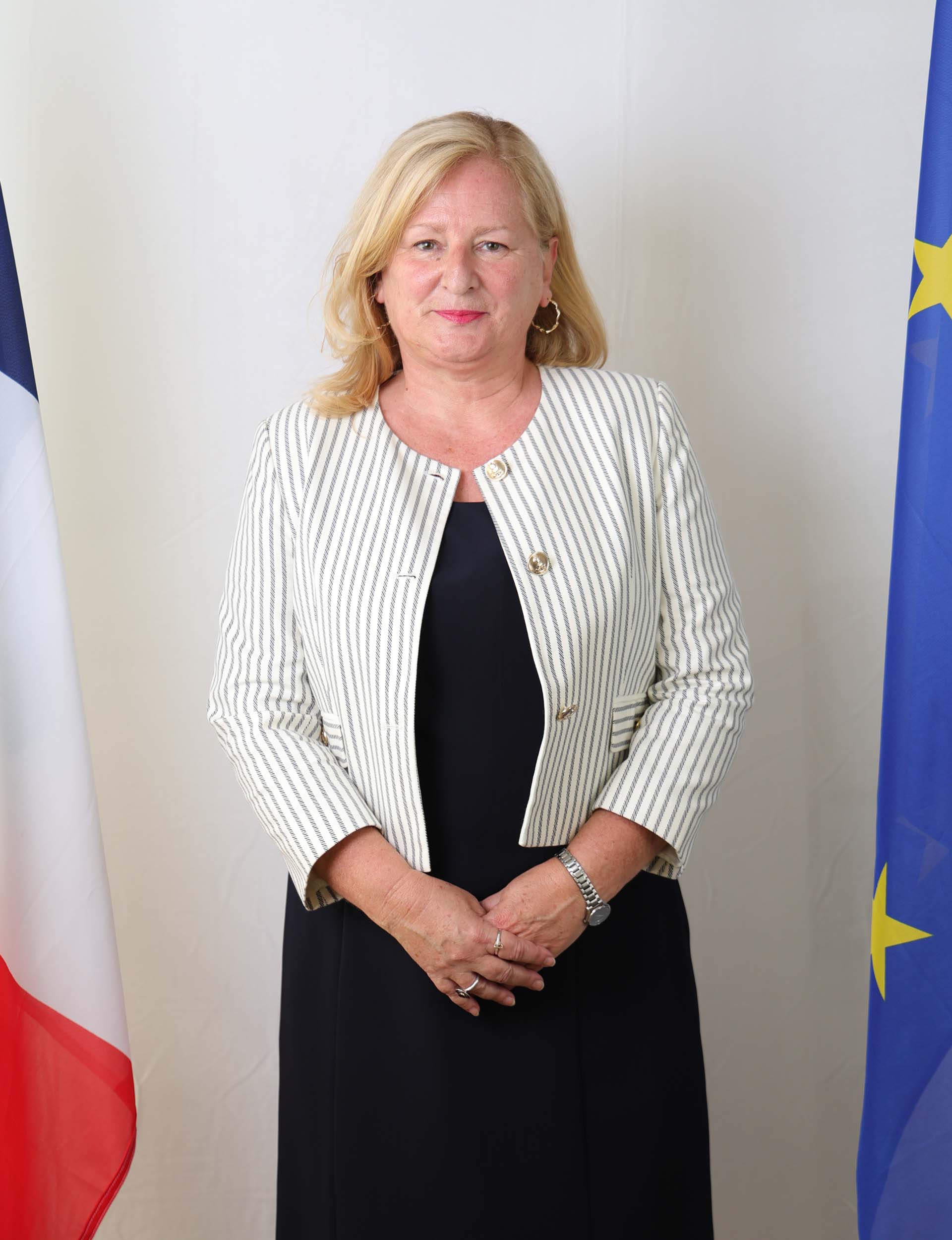
As a longstanding friend of Nepal, how, according to you, has France supported Nepal’s journey?
As a true friend of Nepal, France has shown solidarity during the hard times in Nepal.
Following the 2015 earthquake, a rescue mission with equipment and medical supplies had arrived in Nepal. We also had a civil security unit that installed a temporary water treatment plant at the then Alliance française location in Teku and stayed for more than a month. This treatment plant provided drinking water to locals of Teku as well as in various different areas in Patan, Kathmandu, Bhaktapur, Bungamati, Khokana, and outside of the valley, like Jeevanpur near Dhading. In 2021, in order to combat the COVID-19 crisis in Nepal, the French Government (French Ministry of Foreign Affairs/Crisis and Support Centre) sent a 7-ton humanitarian cargo.
The relief equipment consisted of masks, antigen test kits, respirators/ventilators, and protective glasses. Similarly, the French government also sent over 1.5 million COVID-19 vaccines to Nepal. More recently, following the glacier lake outburst in August 2024 in Thame village in Solukhumbu district, the French government provided immediate assistance of 20,000 Euros to support 55 households.
Nepal and France established a Bilateral Consultation Mechanism to elevate their bilateral ties. How was the recent meeting and were there any notable visits in the recent past?
In 2019, Nepal and France established a bilateral consultation mechanism that provides a platform to discuss our bilateral relations and cooperation, as well as regional and global concerns. Similarly, this year, the 5th such meeting took place in Kathmandu, where my Director for the Asia and Oceania department at the French Foreign Ministry, Mr Benoît Guidée, led the delegation from the French side. During the consultations, the two sides held comprehensive discussions on a range of topics that included economic partnership, science, technology, education, culture, and climate action. We expressed mutual interest in strengthening cooperation in both existing and emerging sectors, such as renewable energy, early warning systems for disaster risk reduction, etc.
In recent years, we have also had parliamentary visits from France. As you know, we have friendship groups in the parliaments of both our countries. In France, we have two such groups: one in the National Assembly (the Lower House) and another in the Senate (the Upper House). In 2022, the Presidents of both groups visited Nepal and met their counterparts as well as members of the civil society. In 2019, France welcomed the then Prime Minister Mr KP Sharma Oli.
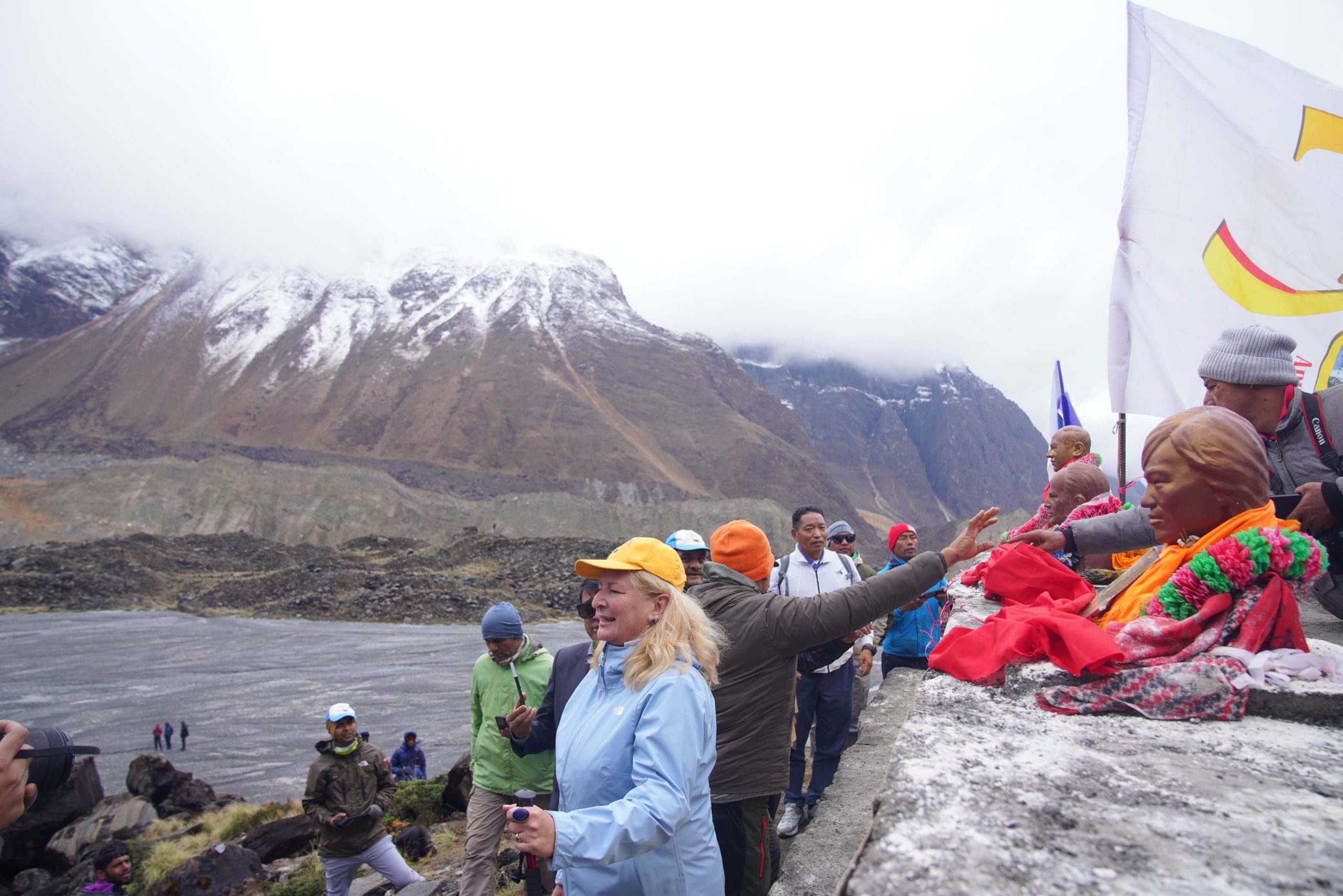
This year marks the 75th anniversary of the first successful ascent of Annapurna by a French team. How has the French Embassy been commemorating this historic event?
This year is a significant milestone in our bilateral relations, which is marked by the mountain. June 3 marked the 75th anniversary of the first ascent of Annapurna by a Franco-Nepali expedition team. On June 3, 1950, Maurice Herzog and Louis Lachenal reached the summit of Annapurna. It was a feat that proved what humans could collectively achieve. Without the support of the Nepali Sherpas, the mission would not have been successful. Ever since, the mountains have played the role of a bridge between our people. This year, the French Embassy’s priorities are focused on the theme of “Mountain.”
To commemorate this special year, the Embassy, along with the Alliance Française, organised various events to celebrate this historic achievement. On April 4, we organised a photo exhibition “Summit of Friendship: 75 Years of Annapurna Ascent.” The exhibition not only retraced the Annapurna ascent but also highlighted the contributions of Nepali climbers, the evolution of mountaineering, and key milestones over the years. This exhibition has been gifted to the Mountain Museum in Pokhara.
On April 23, we hosted a special screening of the documentary “Annapurna, History of a Conquest” by director Bernard George. The event was followed by a panel discussion titled “Mountain Matters: Sustaining the Spirit of Mountains” and was conducted in Nepali. For this discussion, we wanted to bring together the key stakeholders of the mountain ecosystem: Mr. Jérôme Édou, founder of Base Camp Trek and Tibetologist; Ms. Kalpana Maharjan, mountaineer and journalist; Mr. Mingma Chhiri Sherpa, Chairperson of Khumbu Pasang Lhamu Rural Municipality; and Mr. Tul Singh Gurung, President of the Nepal National Mountain Guide Association (NNMGA).
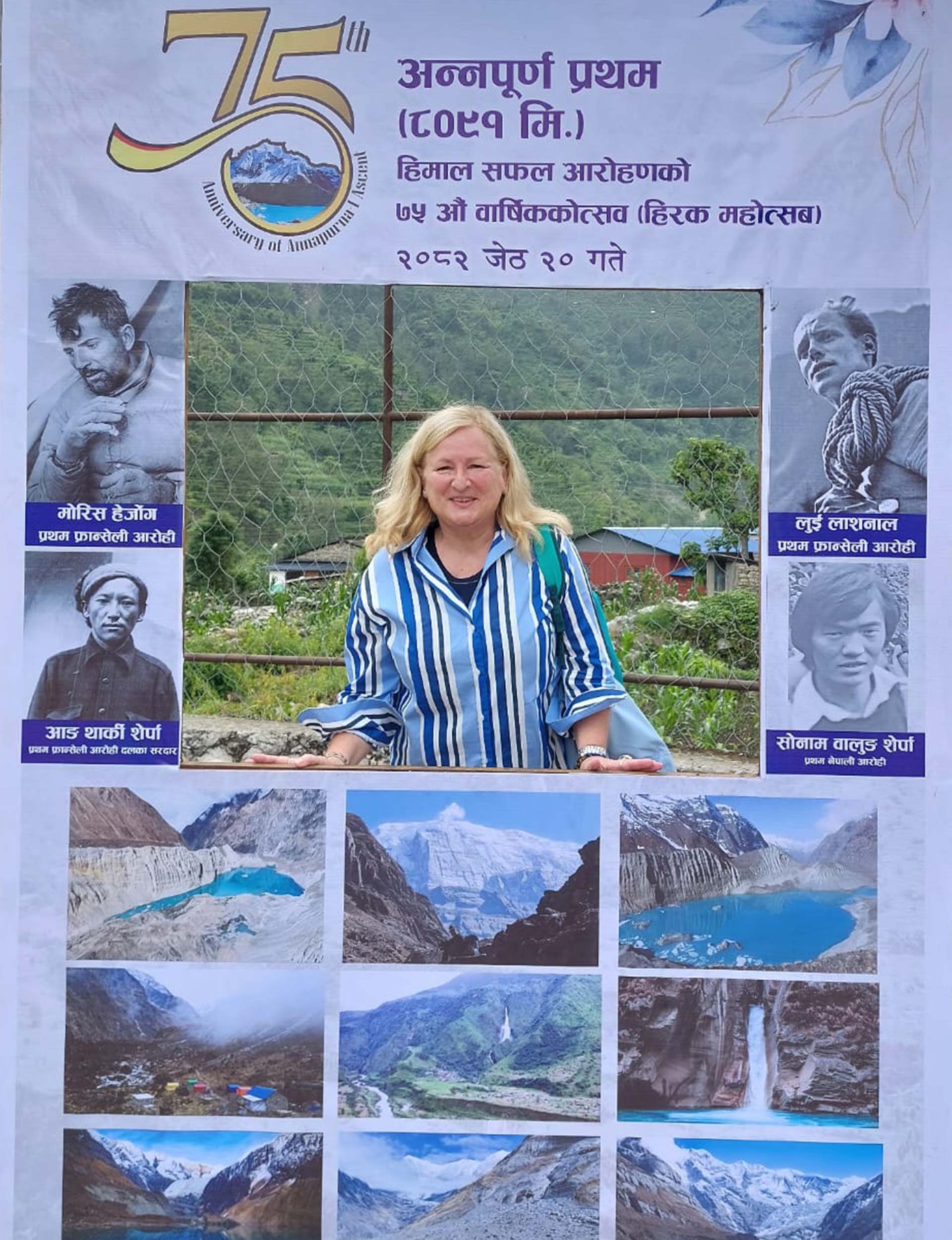
In order to further spread our messages, both Nepal and France jointly appointed Ms Purnima Shrestha, one of the first Nepali women to climb the Annapurna, as the Goodwill Ambassador for this 75th anniversary.
On June 3, various Nepali partners organised events at the Annapurna Base Camp and in Narchyang (Annapurna Rural Municipality) featuring the unveiling of statues of Maurice Herzog, Louis Lachenal, and Walung Sonam Sherpa (first Nepali to summit the Annapurna), the inauguration of the Maurice Herzog Trail, the Annapurna Himalaya Open Museum, and the first Maurice Herzog Annapurna Marathon. I was honoured to participate in these events, which were attended by dignitaries that included Rt. Hon. Prime Minister K.P. Sharma Oli, and Hon. Minister for Culture, Tourism and Civil Aviation Badri Prasad Pandey.
Recently, the French Embassy and the Nepal Mountaineering Association jointly organized a program at the International Mountain Museum in Pokhara. Could you tell us more about that event?
On June 5, a commemorative ceremony was held at the International Mountain Museum in Pokhara and was jointly organised by Nepal Mountaineering Association and the French Embassy. The programme included the unveiling of statues of Maurice Herzog, Ang Tharkay Sherpa (sirdar of the 1950 expedition), and Walung Sonam Sherpa by the chief guest, Hon. Minister for Culture, Tourism and Civil Aviation, Badri Prasad Pandey.
Meanwhile, Hon. Minister for Forest and Environment of Gandaki Province Bhesh Bahadur Poudel and I, we jointly inaugurated and handed over the photo exhibition “Summit of Friendship: 75 Years of Annapurna Ascent” to the museum. A special moment of the ceremony was the loan to the International Mountain Museum of Maurice Herzog’s original 1950 ice axe, brought from the Olympic Museum of Lausanne by his son, Mathias Herzog, as well as the unveiling of the cover of the upcoming Nepali translation of Herzog’s seminal book Annapurna: Premier 8000, by Mathias Herzog and Cyril Sonam Sherpa (grandson of Ang Tharkay Sherpa).
Are there any upcoming events planned to continue the celebration of the Annapurna ascent anniversary?
In October/November of this year, we will be organising another discussion programme focusing on climate change in the Himalayas. Unlike the first discussion, which was aimed at a wider audience, our second discussion will be geared towards the scientific/research community and will be organised in collaboration with the French researchers from the University of Grenoble, as well as with Nepali institutions. This can also be seen as a continuity of key events hosted by Nepal and France this year in the field of climate: Sagarmatha Sambaad and the third UN Ocean Conference.
Our two mountain ecosystems have remained closely connected since 1950. We have mountain guides and alpinists from both countries who train in various formats. I’m very happy to share that this Embassy is providing financial support to Nepali guides for ski training in Chamonix, a renowned French destination for mountaineering. Many French alpinists have climbed summits in Nepal.
Ever since the feat by Herzog and Lachenal, Nepal has occupied the hearts of many French nationals. Many come to Nepal to climb the world’s highest peaks, to trek, or to simply visit your cities. In 2024, there were over 25,000 French tourists, which was 8.5% more than in 2023.
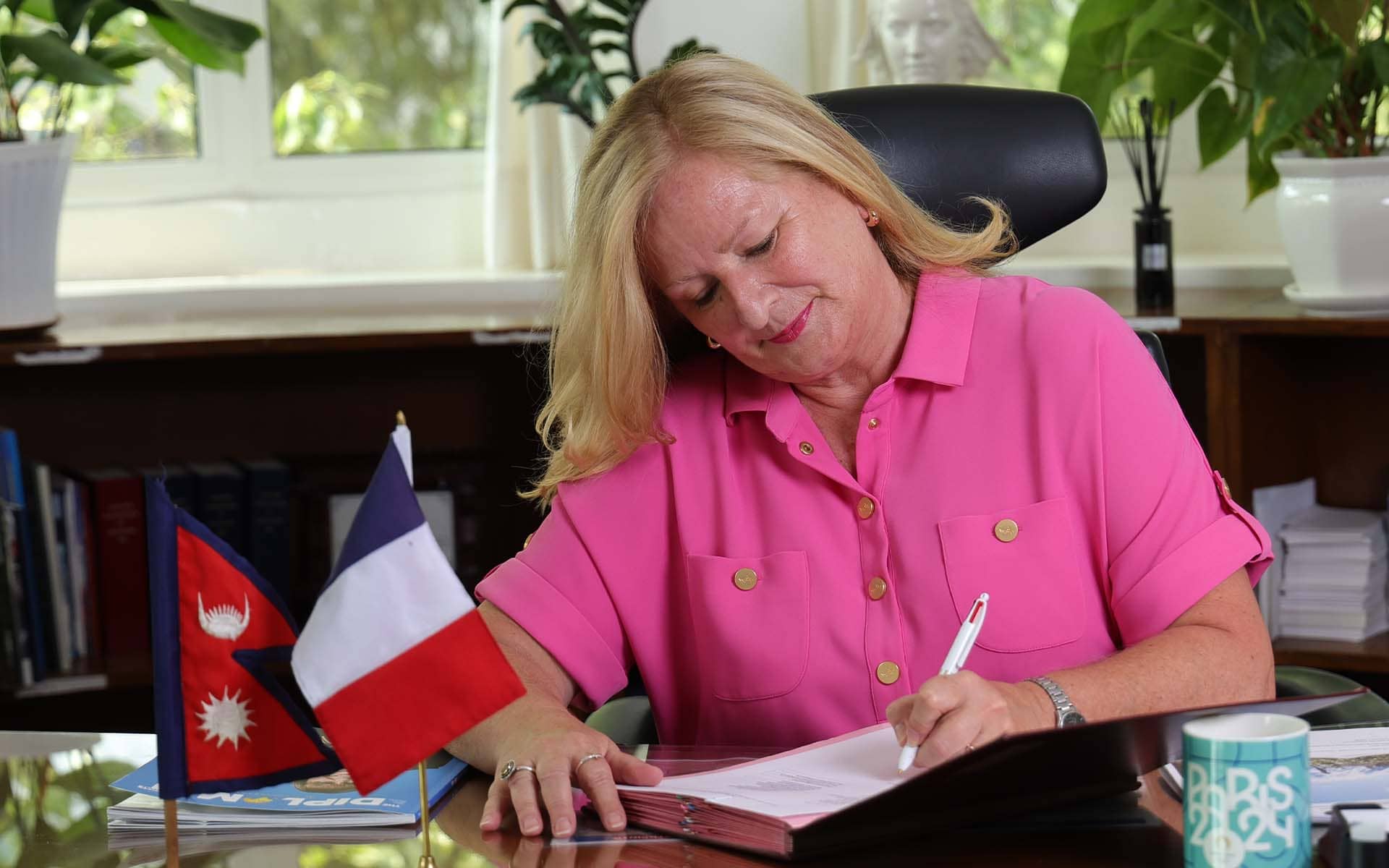
Sports often strengthen people-to-people ties. How do you view the role of sports in enhancing Nepal-France relations?
Indeed, another aspect that nourishes our bilateral relations is sports. Perhaps not many are aware of the “football” relations between our two countries. One of your great players, Samba, has already scored many goals in the French league. Similarly, in Nepal’s football league, we had two French players who played: Vincent Kozeillo and Jeffrey Baltus.
Such opportunities create an environment in which our people-to-people relationships are enhanced.
And of course, there is the Nepal and Paris Olympics 2024 link where Palesha Goverdhan won Nepal’s first Olympic medal (a bronze in Para Taekwondo). Nepal created history, and I’m glad that Paris will forever be inked onto Nepal’s history pages thanks to Palesha’s performance.
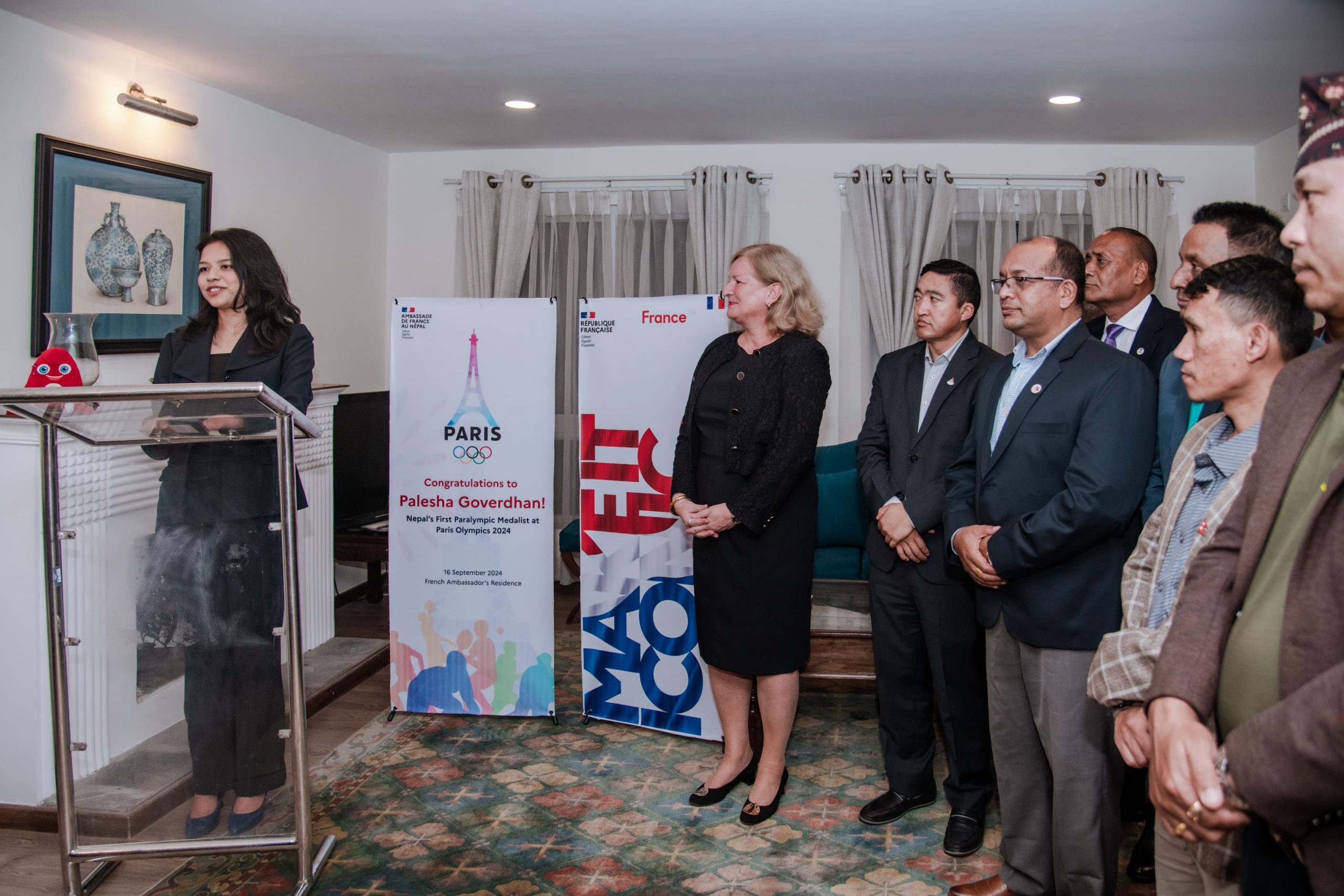
How do you see the role of cultural collaboration and creative industries in strengthening ties between the two countries?
Paris remains a world destination for fashion/haute couture. We know that at least two Nepalis have made it there. One is Sujan Gurung, a young man who works in a highly specialised area: a plumassier or the feather artist. Did you know that he created the iconic dress for Lady Gaga in the opening of the Paris Olympics 2024, and also works with prestigious fashion houses? A scan of French media will give you an indication of his contributions to this highly specialized job.
Another is Chandani Pradhananga, a fashion and textile designer who studied fashion designing in Paris and later launched her own brand, SCHANDANI. She has also opened an atelier in Kathmandu. These are the success stories that inspire and will play an essential role in cementing Nepal-France relations.
How do you view the current trade and investment climate in Nepal, and what role do you see French businesses playing in the country’s economic growth?
On the trade and business front, we are aware that our trade exchanges remain limited and that there is a lot of scope. Nevertheless, for its first operation in Nepal, Proparco, which is the private sector financing arm of Agence Française de Développement Group (AFD Group), has contributed $11 million to the financing of the Upper Trishuli 1 hydro project.
Recently, we have seen the entry of the Accor Group, a world-leading hospitality group, which entered Nepal as Mercure Kathmandu.
We also have Blue Water Intelligence (BWI), a French private basin digitization company dedicated to providing AI-powered hydrological forecasts to governments and companies, which signed an MOU with the Nepal Electricity Authority. This initiative marks a milestone in digitizing Nepal’s river basins to optimize its vast hydropower resources and support preparedness for hydrological risks. We all know of the potential of the investment opportunities in Nepal; however, this potential has not truly been transformed into reality. In this regard, solid incentives would really help to put Nepal on the map for French investors.
Lastly, can you share some of your personal experiences and memorable moments during your time in Nepal?
This is my second time in Nepal, and I am very happy to be back as I have many friends here and numerous wonderful memories and experiences. I have witnessed the resilience of Nepalis during the earthquake and my unforgettable trek in Upper Mustang.
I am quite fond of Nepali cuisine, from Mustang aloo to yamari to chicken sandheko. I would love to discover parts of Nepal that I don’t know yet, like Dolpo.